Art Nouveau – History of This Early Modern Art Movement
What is the Art Nouveau period? What did the movement accomplish? And who are the defining figures of this famous art style? These are just a few questions you may have about the movement known as Art Nouveau, which has significantly contributed to the development of Modern art and a variety of unique art styles shared between the visual and applied arts. In this article, we will discuss the Art Nouveau period, which preceded Modernism and dominated the Western-European world during the late 19th century. We will also explore a few interesting Art Nouveau artists and artworks, which will aid your understanding of the movement and what it encompassed across the visual, decorative, and applied arts.
Contents
- 1 What Is Art Nouveau?
- 2 Pioneers of the Art Nouveau Movement
- 3 Famous Art Nouveau Artworks
- 3.1 Vase with Peacock Feathers (1889) by Auguste Delaherche
- 3.2 The Stomach Dance (1894) by Aubrey Beardsley
- 3.3 Woman Before a Mirror (1897) by Henri de Toulouse-Lautrec
- 3.4 Emerald Pendant (c. 1900) by Georges Fouquet and Alphonse Mucha
- 3.5 The May Queen (1900) by Margaret Macdonald
- 3.6 Judith and the Head of Holofernes (1901) by Gustav Klimt
- 3.7 Maude Adams (1872–1953) as Joan of Arc (1909) by Alphonse Mucha
- 3.8 Lovers (1913) by Egon Schiele
- 4 A Summary of the Characteristics of Art Nouveau Art
- 5 Frequently Asked Questions
What Is Art Nouveau?
What does Art Nouveau refer to? And what was this movement inspired by? The Art Nouveau period refers to a cultural movement inspired by the need for modernization across the visual and applied arts, which included innovative designs and approaches to the fields of architecture, design, graphics, decorative, and fine arts, which generated new art styles across Europe.
The term “Art Nouveau” refers to a “new art style”, which originated in the late 19th century with the British Arts and Crafts movement. The movement was based on the rejection of the Victorian approach to decorative art, which was considered as too “cluttered”. A journal called Le’Art Moderne emerged in the 1880s, which helped launch the new art style movement and was established by a collective of designers and painters seeking cultural reform. The collective, called Les Vingt, held its own Salon exhibitions on an annual basis to promote these new art styles and collaborate with global artists.
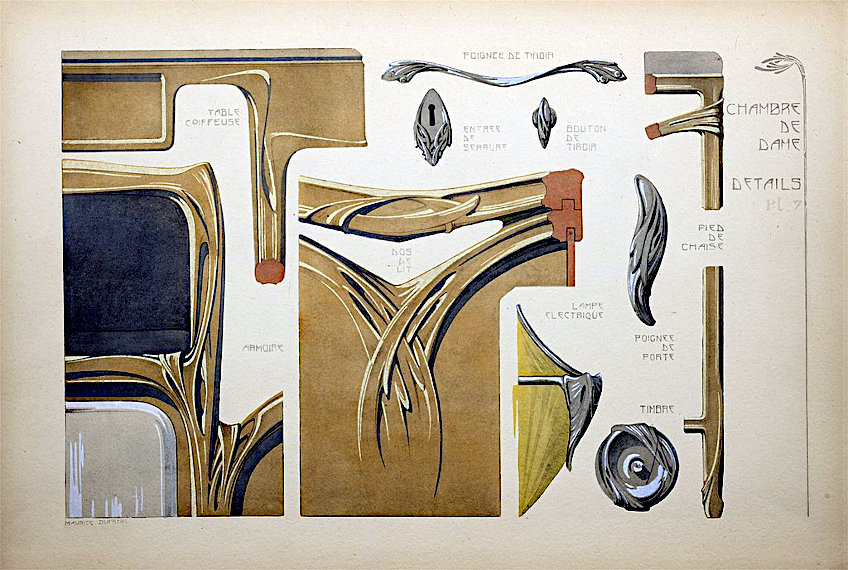
The use of the term “Art Nouveau” was popularized by an 1895 establishment called Maison de l’Art Nouveau. The founder of Maison de l’Art Nouveau was Siegfried Bing who helped propel the integration of Japonism across Europe. Maison de l’Art Nouveau publications were devoted to the exhibition of Japanese art, which exposed aspiring designers and artists to Japanese art styles and was thus crucial to the widespread preference for “modern. The Art Nouveau movement also highlighted a fascination and exoticization of Japanese culture and design, inspired by Japanese woodblock print art styles and Ukiyo-e designs. Defining Art Nouveau motifs and stylistic elements like whiplash curves and floral motifs were adopted from Ukiyo-e art.
Variations of the Art Nouveau Style
The Art Nouveau movement took on different names across different regions. In 1895, a German trader named Siegfried Bing who was a specialist in Japanese art opened up a new store called L’Art Nouveau, which grew in popularity in the decorative arts and furniture sector in Paris. The styles promoted under L’Art Nouveau became synonymous with other merging “new art styles”, including the German style Jugendstil, which was identified as the youth style, and the Vienna Secession movement in Vienna, which you may recognize by the art of its pioneering artists, Gustav Klimt, and Josef Hoffmann. In Spain, the new art style was identified as the Modernismo and Modernisme movements.
Art Nouveau in Asia originated in Japan with the imagery of flowers, natural motifs, and woodblock printing styles that appealed to the Western-European admiration of flat dimensions and decorative features. Japanese art styles greatly influenced the development of poster art and advertising across fashion, entertainment, design, and advertising.
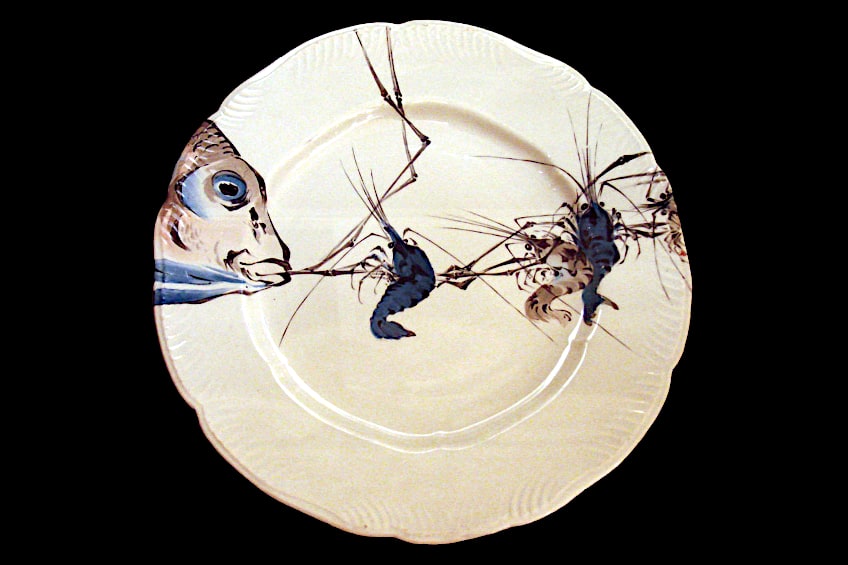
Other popular terms associated with Art Nouveau include the Style Nouille, the Bandwurmstil, the Paling Stijl, and the Nieuwe Kunst. These emerging art styles grew in popularity according to the demands and cultural preferences of each region; however, the core idea remained the same – the Art Nouveau movement was a race for the discovery of the “new”, which translated as a desire for modernity across society.
Art Nouveau Architecture
The Art Nouveau movement was not only limited to the decorative and “high arts”, but it also extended to architecture and resulted in many innovative designs. The influence of Art Nouveau on architecture was felt in every corner of Europe and in urban environments that applied the new art styles to large-scale architecture and smaller row houses. The use of colorful tiles and terracotta was a trend in Art Nouveau architecture and as such, artists like Alexandre Bigot established his name through the use of terracotta in ornamental décor in Parisian facades and apartment buildings. Art Nouveau architectural developments were also seen in the United States Chicago Stock Exchange and the Wainwright Building by Louis Sullivan.
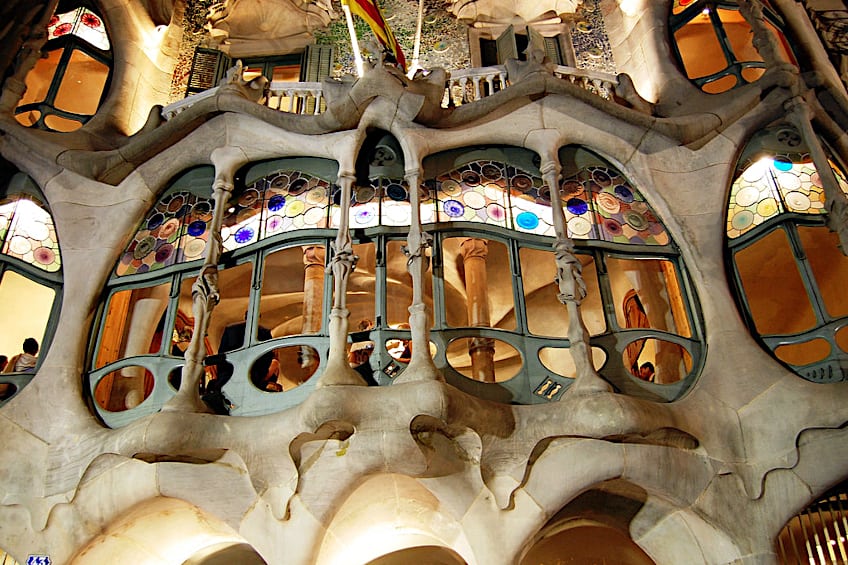
Art Nouveau Design and Illustration
The graphic arts fueled a drive toward new art styles through the reproduction of imagery. Artists from the Art Nouveau period replicated their artworks in other materials such as printed media and advertising literature for extra exposure. This was practiced by artists in Germany and England, including designers such as Audrey Beardsley, who were labeled as “controversial” for featuring macabre designs and erotic imagery.
Other poster illustrators and designers such as Théophile Steinlen and Jules Chéret also helped popularize the glamor of nightlife through graphic illustration and the development of chromolithography to promote modern life. Art Nouveau designs thus elevated the realm of poster illustration and graphics to the “high arts”. The most popular Art Nouveau patterns in design and illustration included motifs such as peacocks, peacock feathers, floral patterns, vines, and ornamental designs inspired by nature.
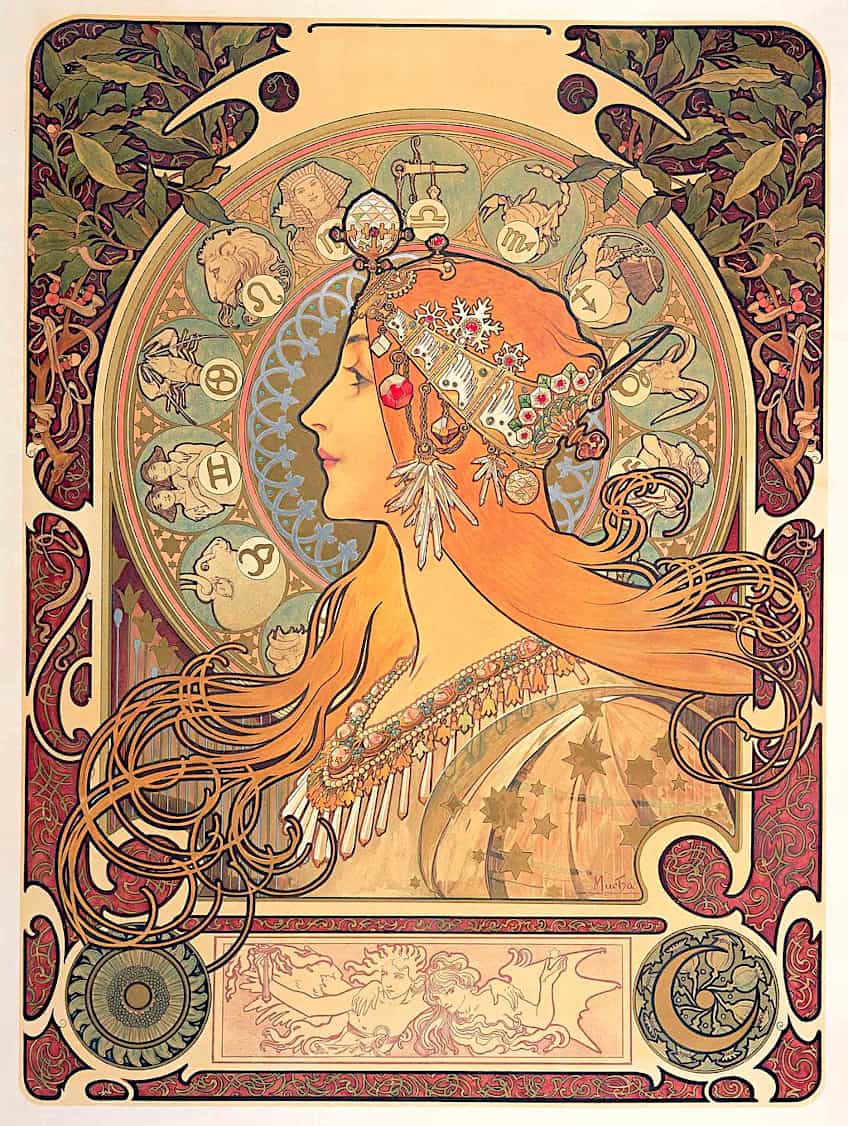
Art Nouveau Furniture Design
Art Nouveau was not only seen in decorative and external features of architecture, it also reached interior design and furniture, which drove the cultural shift. Interior design and furniture were a perfect opportunity for the exploration of Art Nouveau to produce coherent interior environments and was a playground for experimentation with beds, lamp stands, and dining tables. Sinuous curves are also featured in permanent interior architecture through wall paneling and molds. A few popular Art Nouveau designers included figures such as Emile Gallé, Louis Majorelle, and Tony Selmersheim, all of whom piloted the fields of furniture design and interior décor.
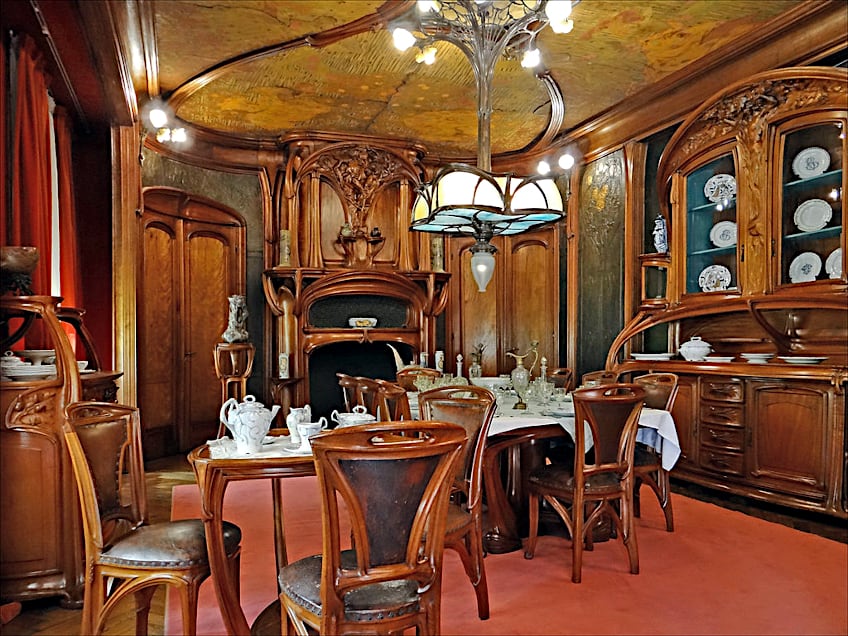
International Art Nouveau Expositions
The late 19th century was the height of Art Nouveau’s promotion, which took place at various international expositions. Five expositions, in particular, were pivotal to the exhibition of decorative art and modern architecture, including Paris’ Expositions Universelles, the Brussels’ Tervueren Exposition, the Turin International Exposition of Modern Decorative Arts, and the Exposition International de l’Est de la France. By 1902, the term Art Nouveau and its art styles across the disciplines of applied and decorative art became the preferred style for most designers in Europe.
Pioneers of the Art Nouveau Movement
The origin of the Art Nouveau movement is not specific to any artwork or artist but is theorized as originating with early post-Impressionists like Vincent van Gogh, who incorporated Art Nouveau elements in painting. The genre of painting is one medium through which Art Nouveau artists in the fine arts drew inspiration from the decorative arts and regional cultures to produce some of the most iconic paintings. The Art Nouveau era also demonstrated the unity of the applied, decorative, and fine arts by providing insight into different ways that Art Nouveau reflected the European culture of urbanization and modernization. Below, we will introduce you to some of the pivotal figures behind the Art Nouveau movement across the fields of visual art, architecture, graphics, and interior design.
Gustav Klimt (1826 – 1918)
| Artist Name | Gustav Klimt |
| Date of Birth | 14 July 1862 |
| Date of Death | 6 February 1918 |
| Nationality | Austrian |
| Movements, Themes, and Styles | Vienna Secession, Symbolism, Art Nouveau, Modern art, decorative art, and fine art |
| Mediums | Painting, and drawing |

Gustav Klimt was one of the leading figures of the Vienna Secession movement whose works incorporated decorative motifs and Symbolist painting with the classical subject matter and religious narratives. Klimt’s reinvention of classical subjects and religious narratives made his work stand out and reached its peak during his “Golden Phase”, which saw Klimt’s generous use of gold leaf alongside geometric shapes, symbols, and ornamental elements. Klimt’s representation of the subject also included distortion, exaggeration, and erotically-charged imagery in dream-like visuals, which freed his work from any preset style that preceded him. The shock value of his work was also quite high, which helped him gain his reputation as one of the world’s best Modernist painters from the Art Nouveau period in Vienna.
Antoni Gaudí (1852 – 1926)
| Artist Name | Antoni Gaudí i Cornet |
| Date of Birth | 25 June 1852 |
| Date of Death | 10 June 1926 |
| Nationality | Spanish |
| Movements, Themes, and Styles | Art Nouveau, and Modernista |
| Mediums | Architecture, ceramic art, ironwork, stained glass, and carpentry |
Antoni Gaudí was a leader in Catalan Art Nouveau Architecture who is best recognized as “God’s architect”. His nickname alone gives one the impression that his architectural talents certainly exceed that of many Art Nouveau architects. Despite his work on the Expiatory Church of the Sagrada Familia remaining incomplete, Gaudí’s many projects can be admired across Barcelona. The field of architecture during the Art Nouveau period included the use of terracotta and vibrant tilework in ornamental designs for interior spaces across other regions like Paris. Art Nouveau architecture styles differed across Europe, with Belgium and France emphasizing iron and glass panels and other areas introducing yellow limestone and wooden trims into residential architecture. Art Nouveau was a widespread cultural shift that infiltrated all fields driven by design and art.
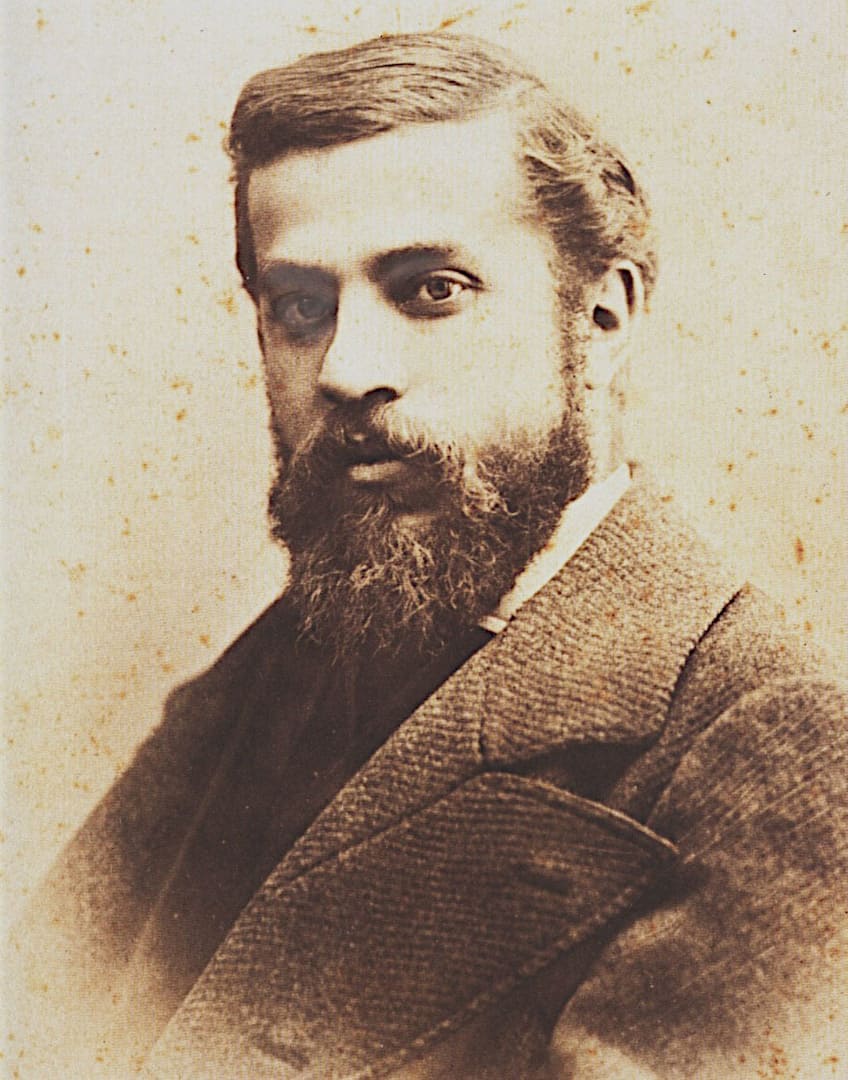
Clara Driscoll (1861 – 1944)
| Artist Name | Clara Driscoll of Tallmadge |
| Date of Birth | 15 December 1861 |
| Date of Death | 6 November 1944 |
| Nationality | American |
| Movements, Themes, and Styles | Art Nouveau |
| Mediums | Graphic design, glass cutting, and lamp design |
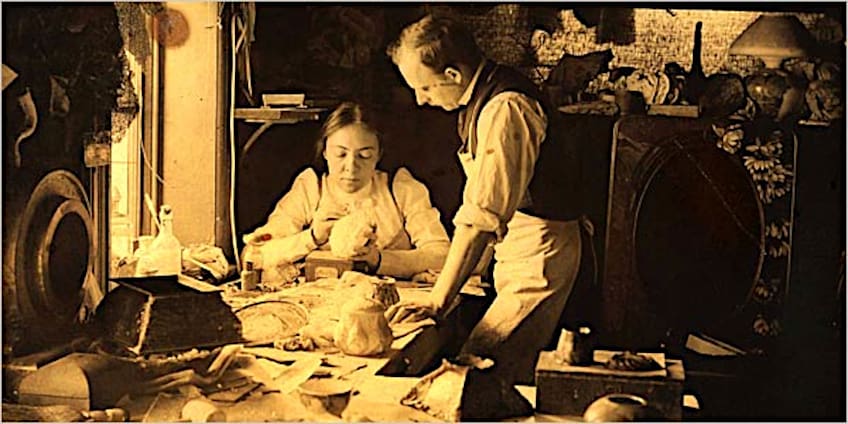
Clara Driscoll was a championing member of Tiffany Studios in New York, who was an ambitious woman who created some of Art Nouveau’s most iconic decorative lamps. Driscoll was not only the highest-paid woman of her century, but she was a talented designer whose floral motifs reflect the influence of Japonisme and Impressionism on her art. Her best designs included the Dragonfly, Peony, Daffodil, and Wisteria lamp designs, each of which is incredibly unique and echoes the essence of Art Nouveau.
Henri de Toulouse-Lautrec (1864 – 1901)
| Artist Name | Comte Henri Marie Raymond de Toulouse-Lautrec-Monfa |
| Date of Birth | 24 November 1864 |
| Date of Death | 9 September 1901 |
| Nationality | French |
| Movements, Themes, and Styles | Art Nouveau, Post-Impressionism, and Modern art |
| Mediums | Drawing, painting, printmaking, and illustration |
Henri de Toulouse-Lautrec was a famous French Art Nouveau painter whose experience in illustration and graphic arts translated well into his representation of Parisian nightlife and Bohemian culture of the 19th century. Toulouse-Lautrec enjoyed observing the culture of decadence and incorporated his passion into his paintings. The French painter was primarily a talented graphic design artist whose many poster designs and illustrations in advertising were seen as modern in the late 1890s and thus did not receive as much attention until his death. Toulouse-Lautrec’s approach to poster design was influenced by Japanese woodblock print styles, which incorporated a sense of movement with flat colors and simple lines and gave his work a comic-like feel.
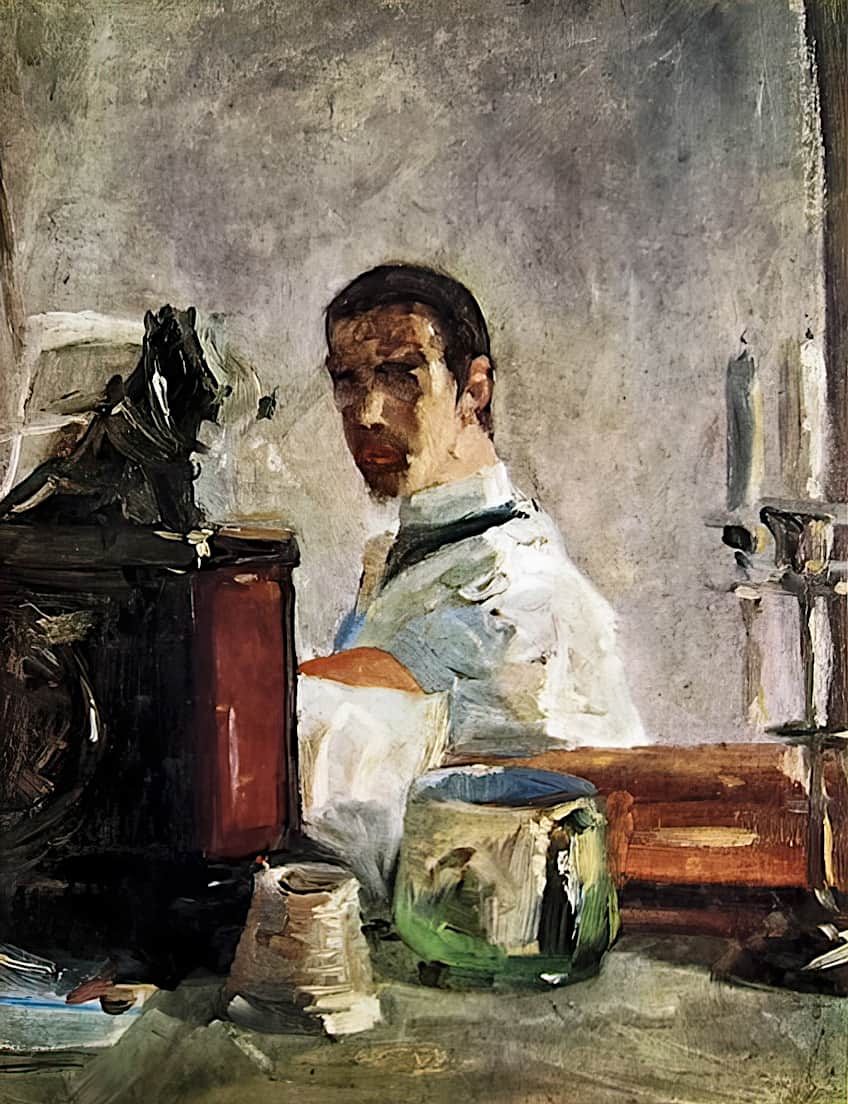
Hector Guimard (1867 – 1942)
| Artist Name | Hector Guimard |
| Date of Birth | 10 March 1867 |
| Date of Death | 20 May 1942 |
| Nationality | French |
| Movements, Themes, and Styles | Art Nouveau, decorative art, and Modern art |
| Mediums | Architecture, drawing, furniture, and design |
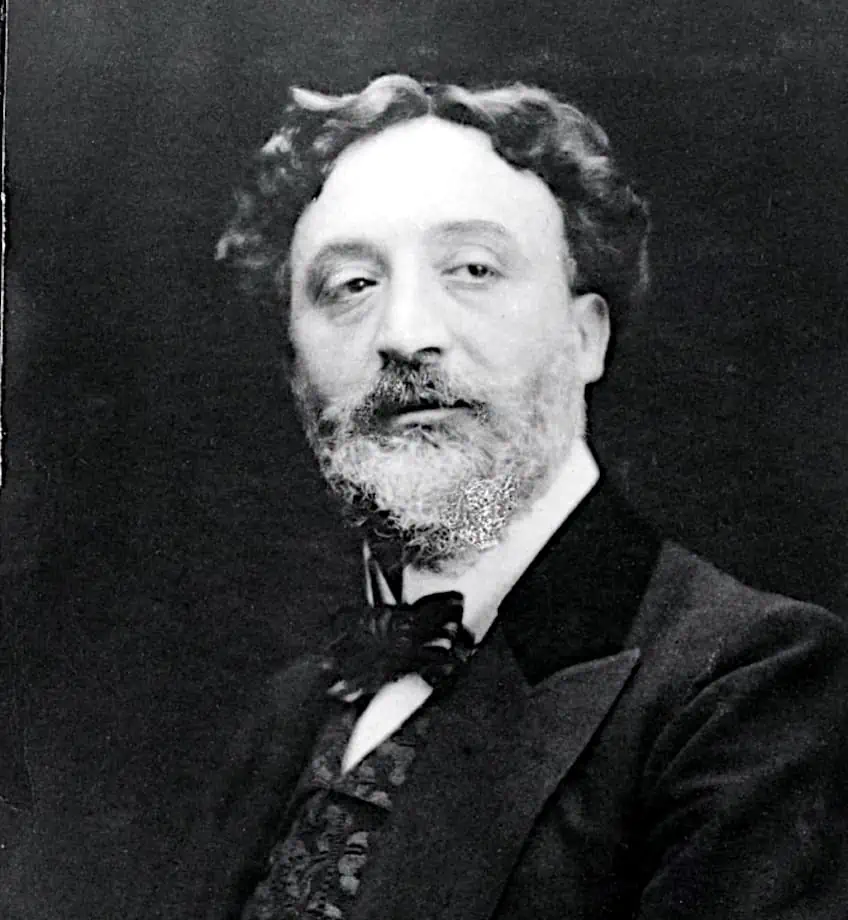
Designer of the Castel Béranger in Paris, Hector Guimard was one of the best Art Nouveau architects of the 19th and early 20th centuries. The Castel Béranger was the first building in Paris to be constructed under the new art style and features ornamental curves as well as iron and glass canopies, which were definitive elements of Art Nouveau architecture. Guimard’s designs also reached the Paris Metro Art Nouveau-styled entrances. Most of his works were later demolished as the Art Nouveau style’s popularity declined but many of his works were still acquired by institutions like the Museum of Modern Art due to the significance of his contributions to the movement. Guimard was also strategic when he unveiled the Castel Béranger, which was the first major work that earned him his reputation. Guimard utilized the opportunity to also exhibit some of his drawings alongside the many colorful details of the building to provide a full experience to its visitors.
Aubrey Beardsley (1872 – 1898)
| Artist Name | Aubrey Vincent Beardsley |
| Date of Birth | 21 August 1872 |
| Date of Death | 16 March 1898 |
| Nationality | English |
| Movements, Themes, and Styles | Art Nouveau, Modern art, and Aestheticism |
| Mediums | Drawing, and illustration |
The influence of line and abstraction on many Art Nouveau artists and illustrators was evident, especially in the works of Aubrey Beardsley. The British artist was one of the most popular Art Nouveau illustrators and graphic artists who was most famous for his illustrations in Oscar Wilde’s play, Salome. Not only were the play and its writer considered controversial at the time, but the play’s ink illustrations in the 1890s also demonstrated Beardsley’s passion for sinuous lines and the Art Nouveau emphasis on exaggeration and “excess”. Beardsley’s work is said to exist between two concurrent art movements: the Art Nouveau and the Aesthetic movement.

Famous Art Nouveau Artworks
The death of Art Nouveau saw the end of its days as early as 1903 with design shifts in Austria and Germany moving away from a sense of Bohemia and more toward geometric designs. This was also followed by a rise in a preference for industrial-esque aesthetics due to the increase in commercial design. The impact of the Art Nouveau movement did resonate decades later into the mid-20th century when artists grew wearisome of the lack of excess in Minimalism. Below, we will review some of the most famous Art Nouveau artworks that played a significant role in influencing the developing art styles of the movement.
Vase with Peacock Feathers (1889) by Auguste Delaherche
| Artist Name | Auguste Delaherche (1857 – 1940) |
| Date | 1889 |
| Medium | Stoneware |
| Dimensions (cm) | 43.7 x 21.9 x 21.9 |
| Where It Is Housed | The Metropolitan Museum of Art, New York City, United States |
Auguste Delaherche was a pioneering French ceramicist of the Art Nouveau period whose exploration of ceramic glaze and texture resulted in some of the best ceramics and porcelain vessels of the century. Delaherche gained his experience from working in many industrial art firms and combined his talents in ceramic sculpture with his love of Japanese pottery to create many stunning vessels with creative Art Nouveau patterns. Peacock feathers were a trendy motif of the Art Nouveau period and were seen as exotic and iridescent. Two pieces with similar designs from Delaherche’s collection were also exhibited at the 1889 Paris Exposition Universelle, where he won a gold medal for his work.
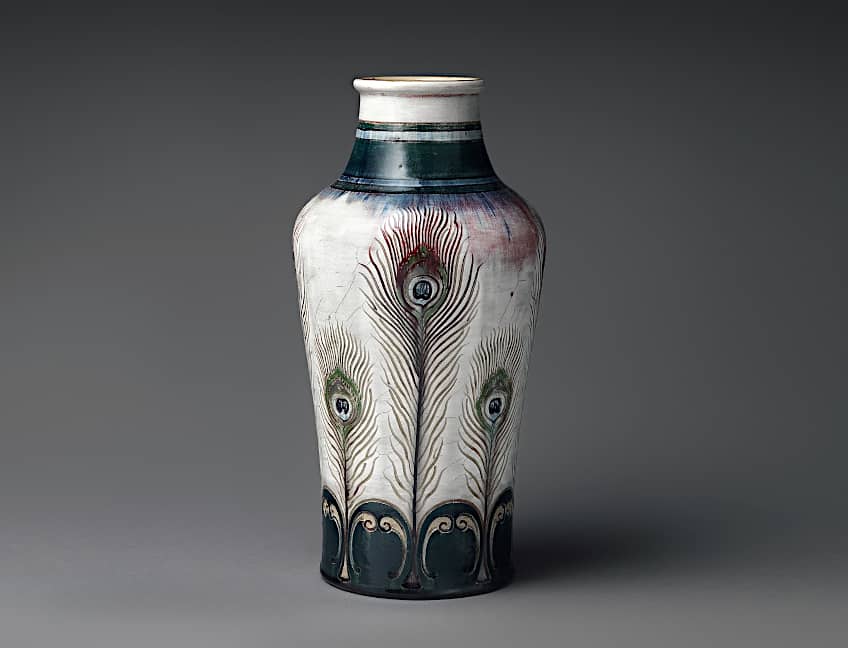
The Stomach Dance (1894) by Aubrey Beardsley
| Artist Name | Aubrey Vincent Beardsley (1872 – 1898) |
| Date | 1894 |
| Medium | Line block print on Japanese vellum |
| Dimensions (cm) | 34.2 x 27.2 |
| Where It Is Housed | Victoria and Alfred Museum, London, United Kingdom |
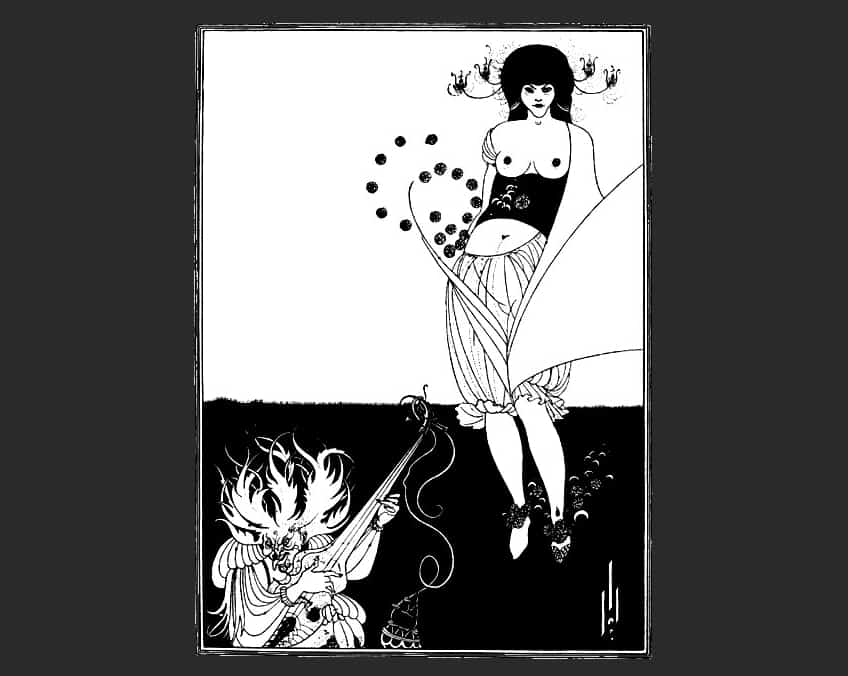
The Stomach Dance is a striking Art Nouveau illustration derived from Oscar Wilde’s Salome and created by Aubrey Beardsley in 1894. The black and white block print illustrates the main character, Salome, performing a dance called “the dance of the seven veils”. In the drawing, her peacock headdress is accentuated and her stomach and breasts are exposed as she dances to the tune of the drooling figure who appears to play a stringed instrument.
Woman Before a Mirror (1897) by Henri de Toulouse-Lautrec
| Artist Name | Comte Henri Marie Raymond de Toulouse-Lautrec-Monfa (1864 – 1901) |
| Date | 1897 |
| Medium | Oil on cardboard |
| Dimensions (cm) | 62.2 x 47 |
| Where It Is Housed | The Metropolitan Museum of Art, New York City, United States |
Henri de Toulouse-Lautrec was fascinated by the nightlife and entertainment culture of 19th-century Paris and as such, chose to represent these Contemporary scenes in his Art Nouveau paintings. Woman Before a Mirror illustrates a woman admiring her form in the mirror and is contrasted by how Toulouse-Lautrec paints her, with no softening of her features. He painted the woman as she appeared and as she was in the middle of appraising herself. One also does not directly see the woman’s expression, yet her comfort with her reflection is what captivates the viewer.
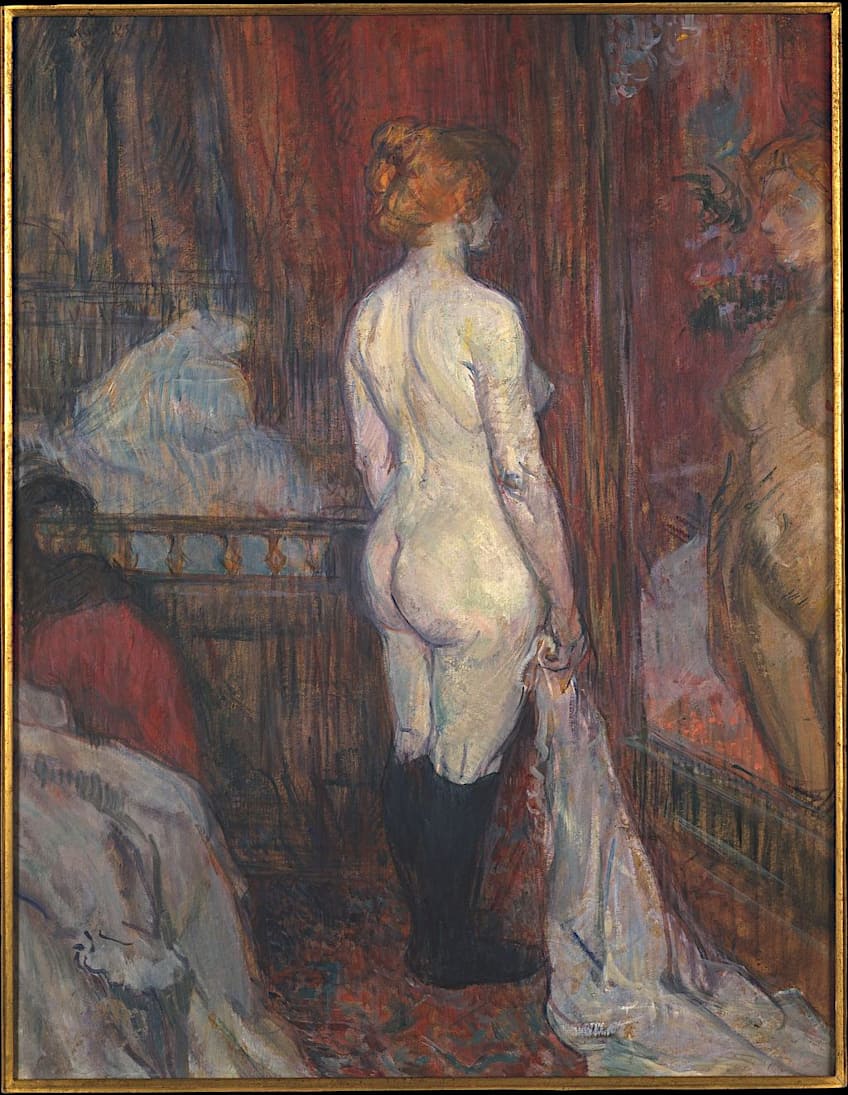
Emerald Pendant (c. 1900) by Georges Fouquet and Alphonse Mucha
| Artist Name(s) | Georges Fouquet (1862 – 1957) and Alphonse Mucha (1860 – 1939) |
| Date | c. 1900 |
| Medium | Gold, opal, emerald, enamel, mother-of-pearl, colored precious stones, and gold paint |
| Dimensions (cm) | 16.5 x 6.4 x 1.3 |
| Where It Is Housed | The Metropolitan Museum of Art, New York City, United States |
Georges Fouquet was a popular Art Nouveau jewelry designer who opened up his own store in Paris in 1900 and often joined hands with Alphonse Mucha to create stunning jewelry pieces such as the pendant above. The duo collaborated from 1899 until 1901, which resulted in an exquisite collection as well as a new showroom at the rue Royale. The pendant was created using a combination of unorthodox materials to reflect the shift of the early 20th century away from precious stones in traditional settings to the selection of materials based on the jewelry’s artistic concept, which dictated its beauty as opposed to the material value. The pendant is extremely intricate and features a mother of pearl, opal, emerald, and other precious stones designed in a classic Art Nouveau style as seen in the curved lines and floral motifs.
The May Queen (1900) by Margaret Macdonald
| Artist Name | Margaret Macdonald Mackintosh (1864 – 1933) |
| Date | 1900 |
| Medium | Mixed media and gesso |
| Dimensions (cm) | 158.8 x 457 |
| Where It Is Housed | Kelvingrove Art Gallery and Museum, Glasgow, United Kingdom |
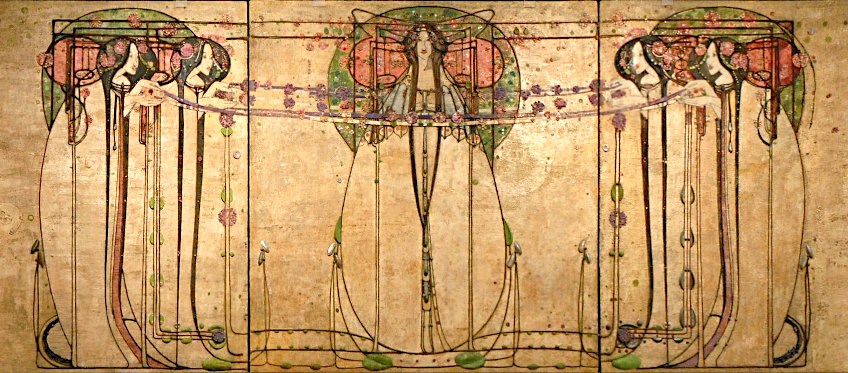
Margaret Macdonald was one of the best Art Nouveau painters of the early 20th century who pioneered the Glasgow Art Nouveau style. Macdonald established a studio alongside her sister and together, the duo created some of the best-known Art Nouveau paintings. The May Queen is an early 20th-century mixed-media painting that shows the influence of Celtic folklore and elongated figures in Macdonald’s work. Macdonald’s unique combination of the elongated figures with geometric shapes, flat colors, and natural designs are what makes her work part of the “new art style”.
Judith and the Head of Holofernes (1901) by Gustav Klimt
| Artist Name | Gustav Klimt (1862 – 1918) |
| Date | 1901 |
| Medium | Oil on canvas |
| Dimensions (cm) | 84 x 42 |
| Where It Is Housed | Österreichische Galerie Belvedere, Vienna, Austria |
Judith and the Head of Holofernes is one of the most famous Art Nouveau paintings of all time, created by Gustav Klimt in 1901. The painting was based on the biblical narrative of a Jewish widow, Judith, who was a heroine figure who saved her town from the hands of an Assyrian general. Klimt portrayed Judith as an alluring femme fatale character using his iconic gilded style and seductive gaze as seen in Judith’s expression.
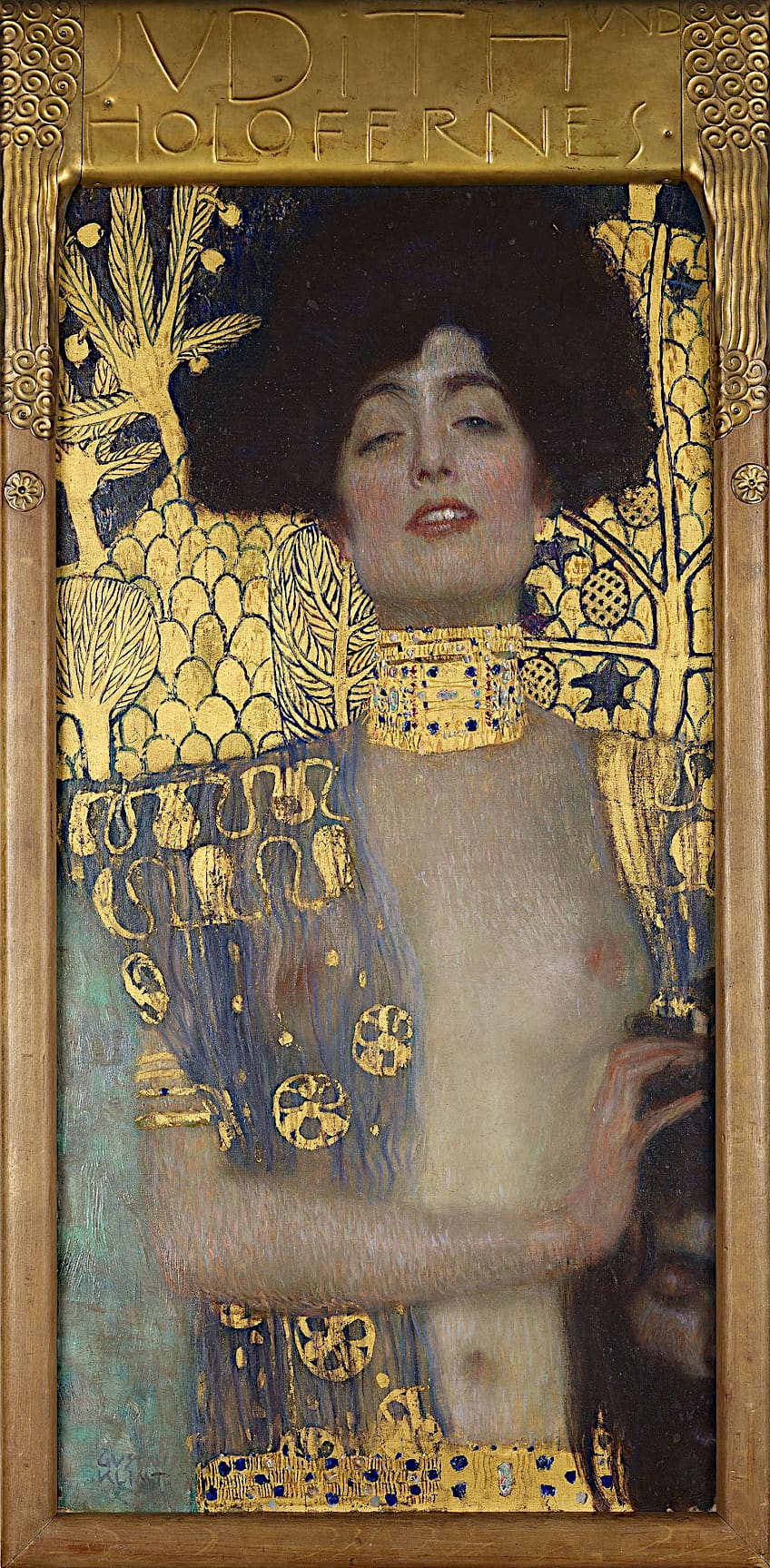
Maude Adams (1872–1953) as Joan of Arc (1909) by Alphonse Mucha
| Artist Name | Alphonse Mucha (1860 – 1939) |
| Date | 1909 |
| Medium | Oil on canvas |
| Dimensions (cm) | 208.9 x 76.2 |
| Where It Is Housed | The Metropolitan Museum of Art, New York City, United States |
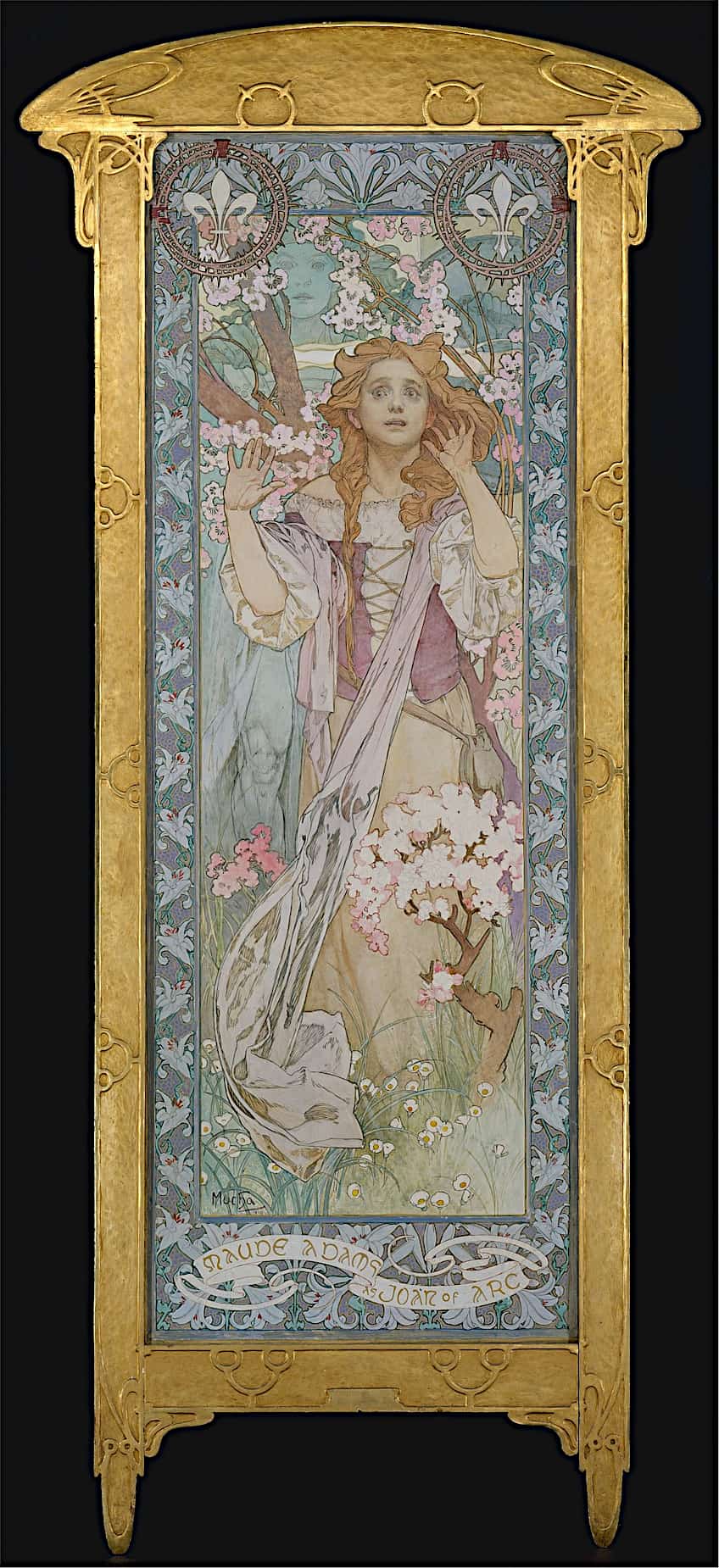
Czech Art Nouveau painter Alphonse Mucha was one of the most famous figures of the Art Nouveau movement in the fine arts. He was recognized for his unique style called the “le style Mucha”, which had a significant influence on the movement. Mucha was also a popular commercial poster designer who focused on the portrayal of the “modern woman”, yet he refused to identify himself as an Art Nouveau artist. Maude Adams (1872–1953) as Joan of Arc showcases the actress Maude Adams as the medieval figure Joan of Arc who is seen stunned by an apparition. Mucha created the painting to promote a gala performance of The Maid of Orleans by Friedrich Schiller, which took place in 1909.
Lovers (1913) by Egon Schiele
| Artist Name | Egon Schiele (1890 – 1918) |
| Date | 1913 |
| Medium | Pencil, watercolor, and gouache on paper |
| Dimensions (cm) | Unavailable |
| Where It Is Housed | Private collection |
Egon Schiele was another major Art Nouveau painter whose paintings reflect his interest in the female nude form and an exploration of sexuality as seen in Lovers. The painting was part of a watercolor series where Schiele placed his girlfriend in sexual positions with his colleague Felix Harta to demonstrate the role reversal of the feminine and masculine energies within each figure. Schiele emphasized the duality of the woman who assumes a traditional male pose while the male figure rests.
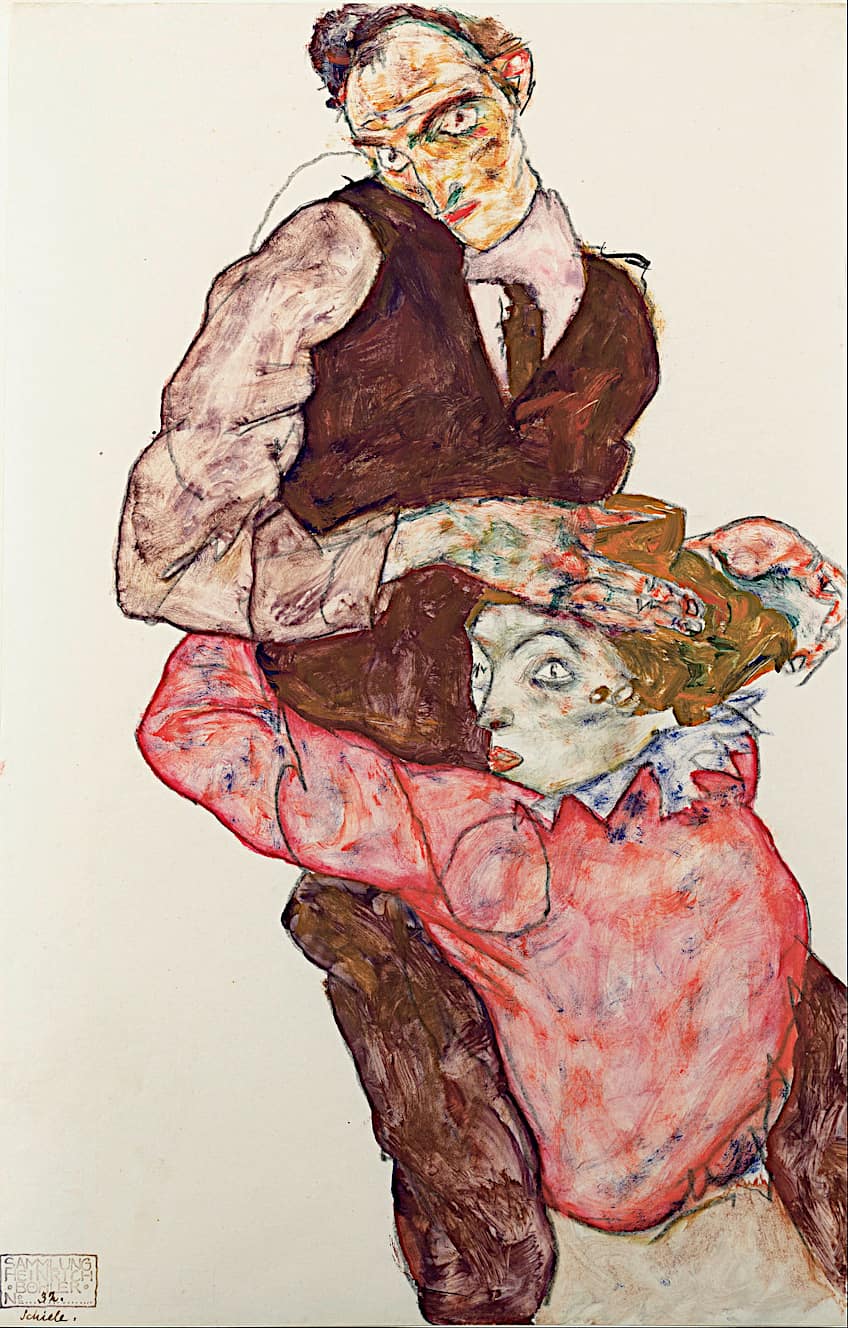
A Summary of the Characteristics of Art Nouveau Art
The characteristics of Art Nouveau artwork as found in the fine arts include the use of S-shaped lines, which are also called whiplash lines as well as a focus on asymmetry, organic shapes, a sense of movement and dynamic aesthetic, and the use of “modern” materials such as iron, glass, and concrete to mimic organic forms.
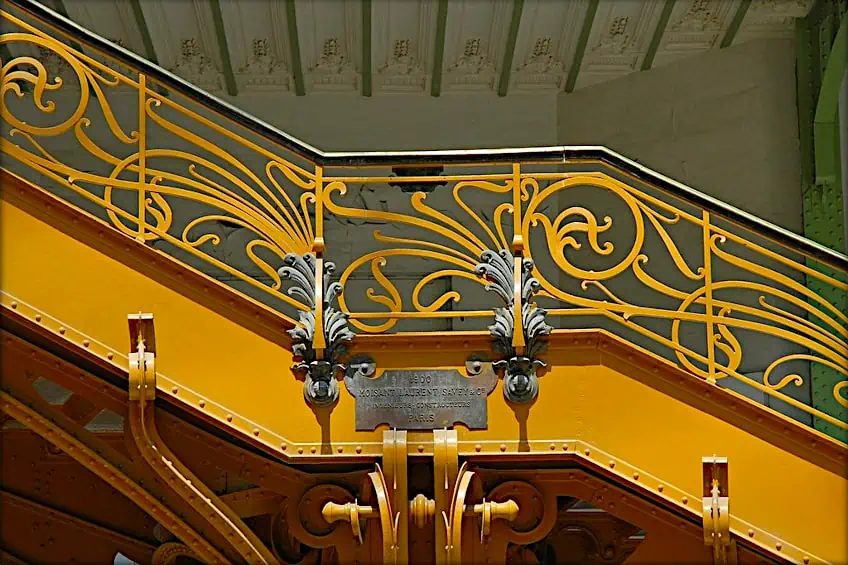
Art Nouveau architecture drew inspiration from the natural environment and featured ornamental and sensual decorative elements. The most popular designs of the Art nouveau period include motifs such as flowers, insects, leaves, and vine-like designs. The most famous Art Nouveau buildings include the La Sagrada Familia in Barcelona, which currently remains under construction with an estimated completion date set to 2026. Other top examples of Art Nouveau architecture include the Hotel Tassel in Brussels, the Museum of Applied Arts in Budapest, the Secession building in Vienna, and the Casa Batllo in central Barcelona.
The use of glass in the Art Nouveau period was also a prominent visual and material characteristic, which evoked a sense of luxury and effortless design. Glass found its way into utilitarian art objects produced by artists and companies like Tiffany and the Daum Brothers. The development of new techniques for glass artworks also influenced the visual characteristics of Art Nouveau design and “art glass” through acid etching methods.
The realm of stained glass was an additional characteristic of the Art Nouveau period and featured frequently in glass art, large panels, and lampshades. Tiffany’s jewelry line by Louis Comfort Tiffany also produced some of the best late 19th-century luxury accessories that capture the Art Nouveau fin-de-siècle-era aesthetic.
The Art Nouveau period was a movement that united the fields of the decorative, applied, and fine arts, and allowed for the development of iconic artworks, art objects, and buildings. Art Nouveau was not just a lifestyle, but also a collaboration between artists, designers, architects, and graphic illustrators on the exploration of what modernity could look like through a utopian lens. The fusion of Japanese art styles with natural motifs and the influence of modern-looking designs and line work was what made the late 19th century Art Nouveau, and is definitely one of the most diverse art movements in art history.
Frequently Asked Questions
What Is Art Nouveau?
Art Nouveau refers to a late 19th-century art movement, which emerged in Europe and was characterized by frustration with the rigid art styles of the Victorian age. The Art Nouveau movement was driven by an influence from Japonism (also known as Japonisme), as well as the fusion of natural motifs and sinuous line work in design, architecture, decorative, and fine arts. The movement was fueled by the need for modernity in art and design, which swept across Europe and the United States.
Who Are the Most Famous Artists of the Art Nouveau Movement?
The most famous artists of the Art Nouveau movement include Gustav Klimt, Egon Schiele, Alphonse Mucha, Henri de Toulouse-Lautrec, Alice Russell Glenny, Clara Driscoll, Aubrey Beardsley, and Margaret Macdonald, among many other designers and illustrators within the applied arts sector.
Is Art Nouveau Classified as Modern Art?
Art Nouveau is not considered to be the same movement as Modern art since each movement was founded on differing philosophies, especially through the lens of architecture. Art Nouveau is a movement that preceded Modernism and thus is regarded as a style in its own right. Art Nouveau is categorized by its style, which promoted sinuous lines and ornamentation in art and architecture between 1890 and 1910, while Modernist art was founded during a period when new construction materials were being discovered and peaked post-World War II across Europe and the West. Modernism was thus philosophized under the desire for a cultural shift and the need for reform due to the rapid urbanization of the early 20th century.
Jordan Anthony is a Cape Town-based film photographer, curator, and arts writer. She holds a Bachelor of Art in Fine Arts from the University of the Witwatersrand, Johannesburg, where she explored themes like healing, identity, dreams, and intuitive creation in her Contemporary art practice. Jordan has collaborated with various local art institutions, including the KZNSA Gallery in Durban, the Turbine Art Fair, and the Wits Art Museum. Her photography focuses on abstract color manipulations, portraiture, candid shots, and urban landscapes. She’s intrigued by philosophy, memory, and esotericism, drawing inspiration from Surrealism, Fluxus, and ancient civilizations, as well as childhood influences and found objects. Jordan is working for artfilemagazine since 2022 and writes blog posts about art history and photography.
Learn more about Jordan Anthony and about us.
Cite this Article
Jordan, Anthony, “Art Nouveau – History of This Early Modern Art Movement.” artfilemagazine – Your Online Art Source. March 9, 2023. URL: https://artfilemagazine.com/art-nouveau/
Anthony, J. (2023, 9 March). Art Nouveau – History of This Early Modern Art Movement. artfilemagazine – Your Online Art Source. https://artfilemagazine.com/art-nouveau/
Anthony, Jordan. “Art Nouveau – History of This Early Modern Art Movement.” artfilemagazine – Your Online Art Source, March 9, 2023. https://artfilemagazine.com/art-nouveau/.



